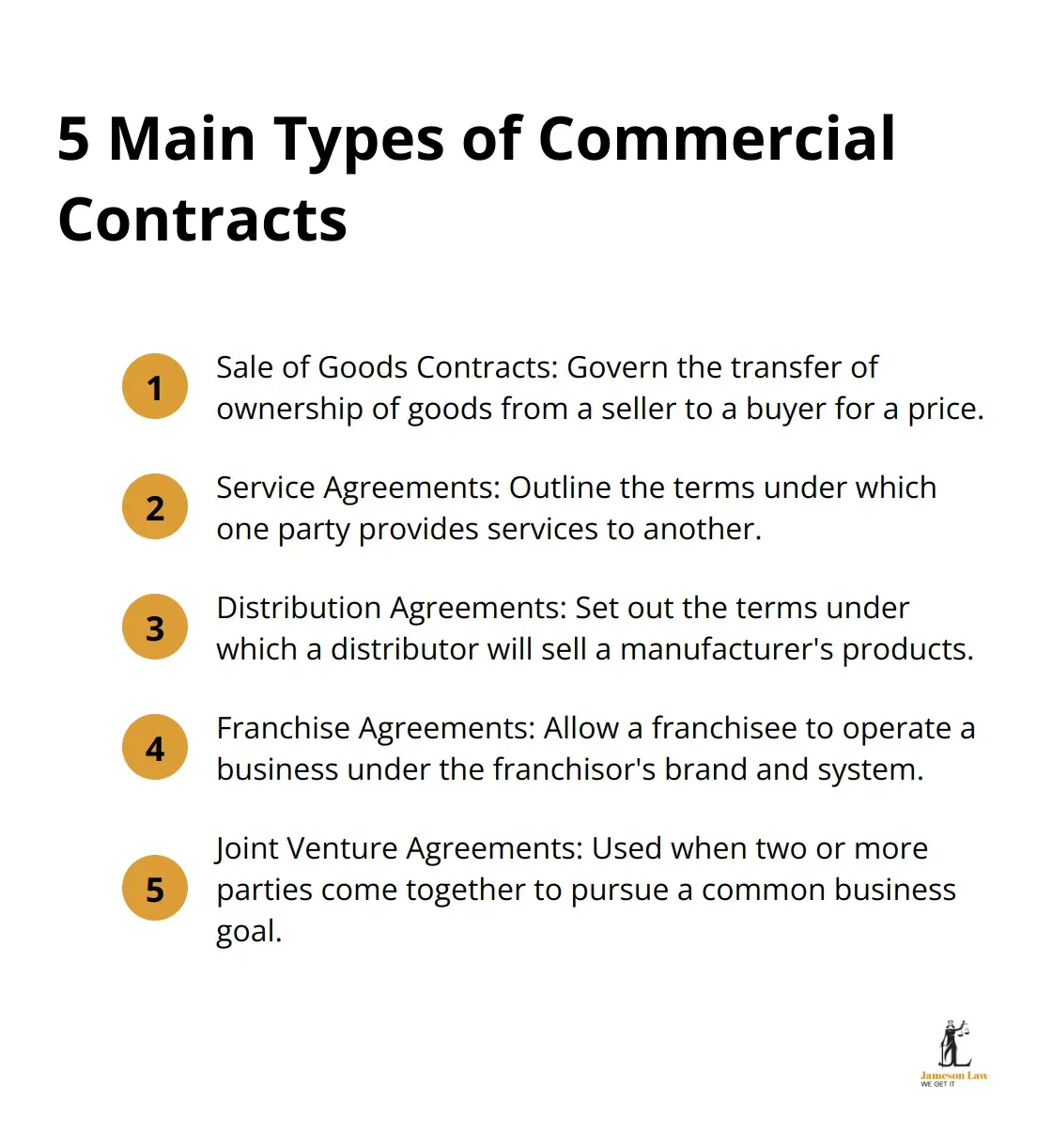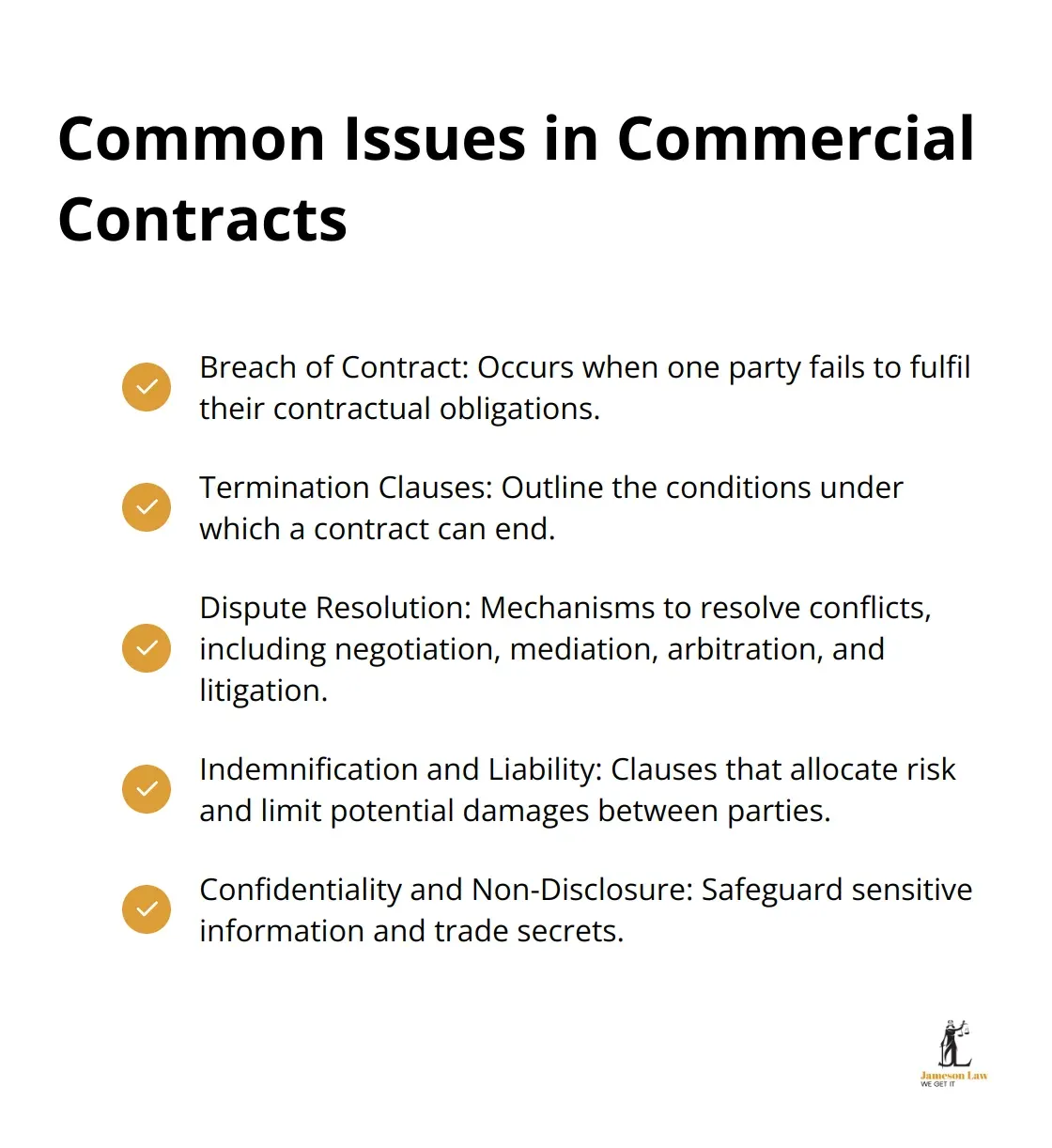Commercial contract law forms the backbone of business relationships. It’s a complex field that governs agreements between companies, setting the rules for their interactions and transactions.
At Jameson Law, we’ve seen firsthand how understanding these basics can make or break a business deal. This post will guide you through the key elements, types, and common issues in commercial contracts, helping you navigate this crucial aspect of business operations.
Key Elements of Commercial Contracts
Commercial contracts form the foundation of business relationships. At Jameson Law, we understand the importance of these agreements in shaping business interactions and transactions. Let’s explore the essential components that make a commercial contract legally binding and effective.

Offer and Acceptance: The Starting Point
Every valid contract begins with a clear offer and an unequivocal acceptance. In the Australian legal system, an offer must be specific and communicated to the other party. Acceptance must match the offer exactly — any variation constitutes a counter-offer. See general contract guidance on business.gov.au.
For example, if a supplier offers to sell 1,000 units at $10 each, and the buyer agrees to purchase 900 units at $10 each, this represents a counter-offer, not acceptance. We always advise clients to document offer and acceptance in writing to prevent disputes.
Consideration: The Exchange of Value
Consideration represents what each party brings to the agreement. It’s the value exchanged between parties, whether money, goods, services, or even a promise to act (or refrain from acting). Without consideration, a contract becomes merely a gift and lacks legal enforceability.
A common issue we encounter involves inadequate consideration. For instance, if a company promises to pay an employee a bonus for “doing their job”, this might not stand up in court because the employee already has an obligation to perform their duties under their existing employment contract.
Intention to Create Legal Relations: Beyond Casual Agreements
Both parties must intend to create a legally binding agreement. In commercial contexts, this intention is usually presumed, but it’s still wise to include a clause stating the parties’ intention to be legally bound (see examples in the Business contracts guide).
We’ve seen cases where informal agreements between friends in business weren’t upheld in court due to a lack of clear intention to create legal relations. It’s always best to clarify your intentions in writing.
Capacity to Contract: Legal Authority to Enter Agreements
All parties must possess the legal capacity to enter into a contract. This means they must be of legal age (18 in Australia) and of sound mind. For companies, it means having the authority to enter into agreements on the company’s behalf — commonly addressed under Corporations Act 2001 (Cth) execution provisions.
A recent matter we handled involved a contract signed by a junior employee who lacked the authority to bind the company. The contract was deemed invalid, causing significant issues for both parties. Always verify who has the authority to sign on behalf of a business.
Legality of Purpose: Staying Within the Law
The purpose of the contract must be legal. Any agreement for illegal activities is automatically void. This extends to contracts that may be legal in other jurisdictions but not in Australia. Check relevant standards and legislation at legislation.gov.au before you sign.
For instance, we once advised a client against entering into a distribution agreement for a product that, while legal overseas, didn’t meet Australian safety standards. Understanding local laws is essential when drafting commercial contracts.
These key elements form the bedrock of commercial contracts. Getting them right from the start can save businesses from costly disputes and legal battles. As we move forward, let’s examine the various types of commercial contracts and how they apply these fundamental principles in different business contexts.
Types of Commercial Contracts
Commercial contracts come in various forms, each tailored to specific business needs and relationships. Let’s explore the main types of commercial contracts and their key features.

Sale of Goods Contracts
Sale of goods contracts govern the transfer of ownership of goods from a seller to a buyer for a price. In Australia, these contracts are primarily governed by state and territory Sale of Goods Acts (for example, the Sale of Goods Act 1923 (NSW)).
A key aspect of these contracts is the clear description of the goods being sold. Product descriptions should be specific and unambiguous to prevent disputes. For instance, when selling industrial machinery, the contract should specify the exact model and performance metrics.
Another important element is the passing of risk — when responsibility for loss or damage transfers from seller to buyer. A clear statement in the contract helps avoid potential conflicts.
Service Agreements
Service agreements outline the terms under which one party provides services to another. These contracts are increasingly common in our digital economy, where businesses often outsource functions. It’s vital to define the scope of services and deliverables clearly, with service levels (SLAs) and performance measures. For practical drafting tips, see business.gov.au.
Distribution Agreements
Distribution agreements set out the terms under which a distributor sells a manufacturer’s products — a key tool for expanding market reach. Consider whether distribution rights are exclusive, non-exclusive, or selective, and set realistic sales targets. If you’re exporting, Austrade offers useful market guidance.
Franchise Agreements
Franchise agreements allow a franchisee to operate a business under the franchisor’s brand and system. In Australia, these agreements are governed by the Franchising Code of Conduct. Disclosure requirements are critical — franchisors must provide a disclosure document to prospective franchisees within prescribed timeframes.
Joint Venture Agreements
Joint ventures are used when two or more parties pursue a common business goal. Clearly set out contributions, responsibilities, decision-making, IP ownership and exit/termination mechanics so each party’s position is understood from the outset.
Understanding these different types of commercial contracts is essential for businesses engaging in various commercial relationships. Each type of contract has its unique features and potential pitfalls. In the next section, we’ll examine common issues that can arise in commercial contracts and how to address them effectively.
Navigating Common Pitfalls in Commercial Contracts
Commercial contracts present various challenges that businesses must address to avoid costly disputes and legal battles. Understanding these common issues can help companies protect their interests and maintain successful business relationships.

Breach of Contract: Prevention and Remedies
Breach of contract occurs when one party fails to fulfil their contractual obligations. In Australia, the most common breaches involve non-payment, failure to deliver goods or services, and not meeting quality standards.
To prevent breaches, contracts should include clear performance metrics and milestones. For example, a construction contract should specify exact completion dates for each project stage. This clarity holds parties accountable and provides a basis for legal action if necessary.
When breaches occur, remedies can include damages, specific performance, or termination of the contract. The choice of remedy depends on the nature and severity of the breach.
To safeguard your business, you should:
![]() Put all significant agreements in writing
Put all significant agreements in writing
![]() Include key terms (payment schedules, delivery timelines, dispute resolution procedures)
Include key terms (payment schedules, delivery timelines, dispute resolution procedures)
![]() Have a commercial lawyer review important contracts before signing
Have a commercial lawyer review important contracts before signing
Termination Clauses: Ensuring Clarity
Termination clauses outline the conditions under which a contract can end. Poorly drafted termination clauses can lead to disputes. Specify grounds (e.g., material breach, insolvency, failure to meet performance standards) and the process (notice periods and opportunities to remedy). See guidance on ending a contract.
Dispute Resolution: Selecting Effective Mechanisms
Effective dispute resolution mechanisms can save time and cost. Options include negotiation, mediation, arbitration and litigation. A tiered clause is often best — start with negotiation, then mediation, and move to arbitration or court only if needed. For cross-border matters, consider enforceability under the New York Convention.
Indemnification and Liability: Managing Risk
Indemnities allocate risk, while liability caps limit exposure. Draft them carefully and ensure they remain enforceable — particularly in light of the unfair contract terms regime under the Australian Consumer Law.
Confidentiality and Non-Disclosure: Safeguarding Information
Protect confidential information with well-drafted NDAs — define what’s confidential, permitted uses and the duration of obligations. Consider privacy and security measures (e.g., OAIC privacy guidance and the Australian Cyber Security Centre’s advice on secure storage): oaic.gov.au and cyber.gov.au. Also ensure advertising and selling practices comply with the ACCC’s Advertising & Selling Guide.
Final Thoughts
Commercial contract law forms the foundation of business relationships in Australia. Companies must understand key elements such as offer, acceptance and consideration to navigate the complexities of these agreements successfully. Each contract type — from sale of goods to joint ventures — presents unique challenges that require careful consideration and expert knowledge.
Professional legal advice proves invaluable when drafting and negotiating commercial contracts. Lawyers can identify potential risks, suggest appropriate clauses and ensure contracts comply with Australian law. We at Jameson Law specialise in commercial contract law and offer tailored legal support to businesses across Australia. If you need help, contact our team.
A well-drafted contract serves as a roadmap for business relationships, not just a legal document. It protects interests, supports goals and mitigates risks when properly constructed. Investing in sound legal advice and prioritising a thorough understanding of commercial contract law sets businesses up for long-term success in the Australian market.













